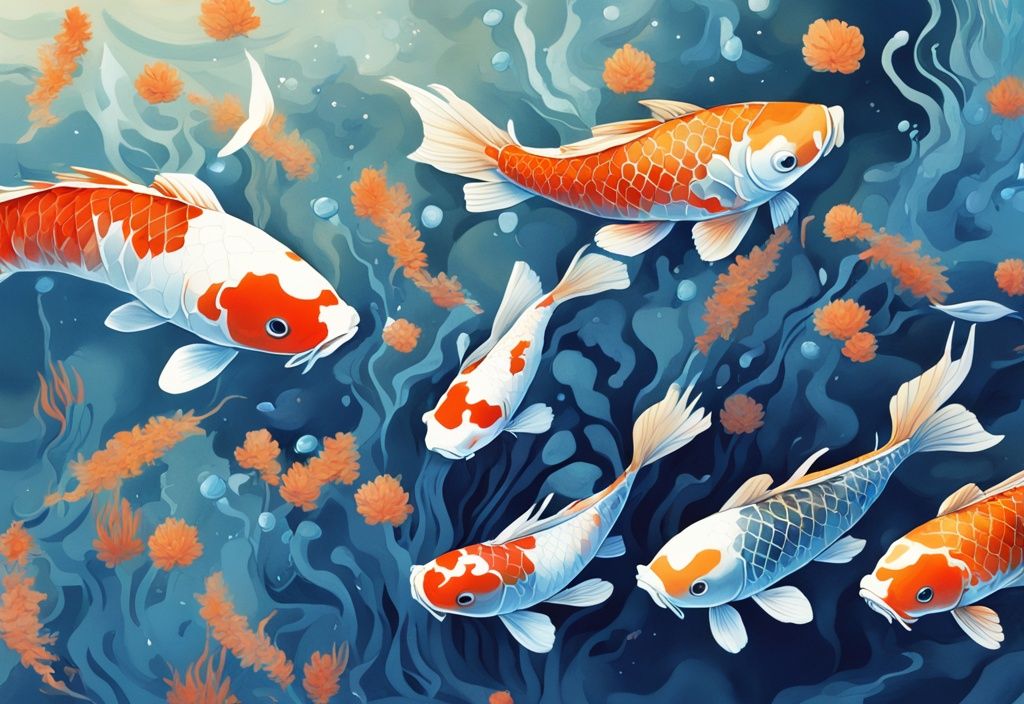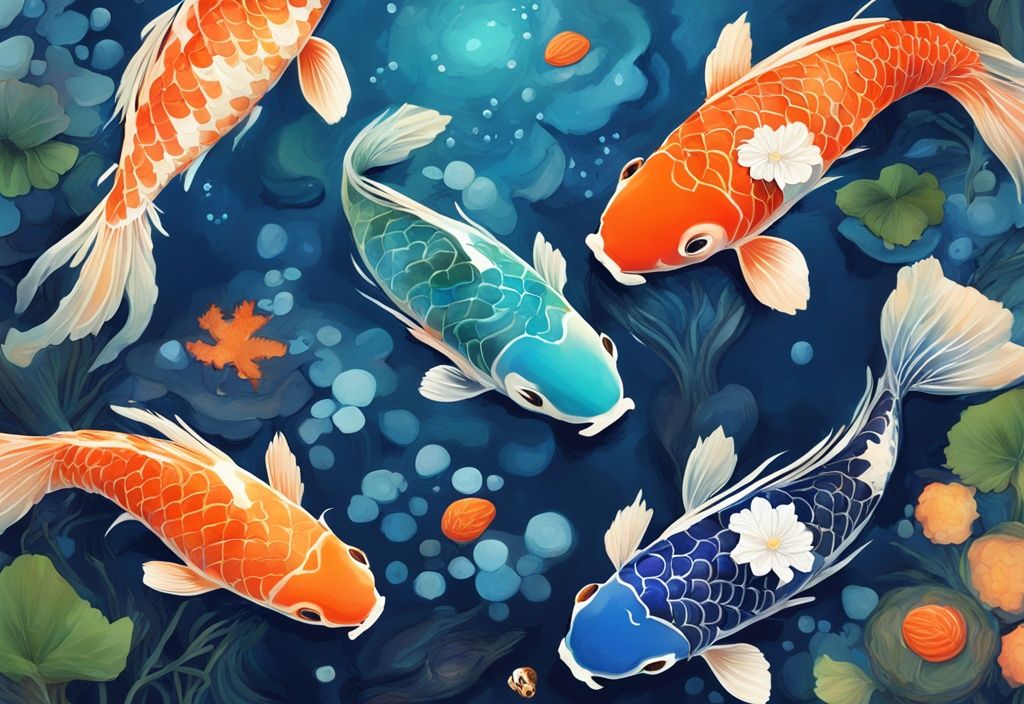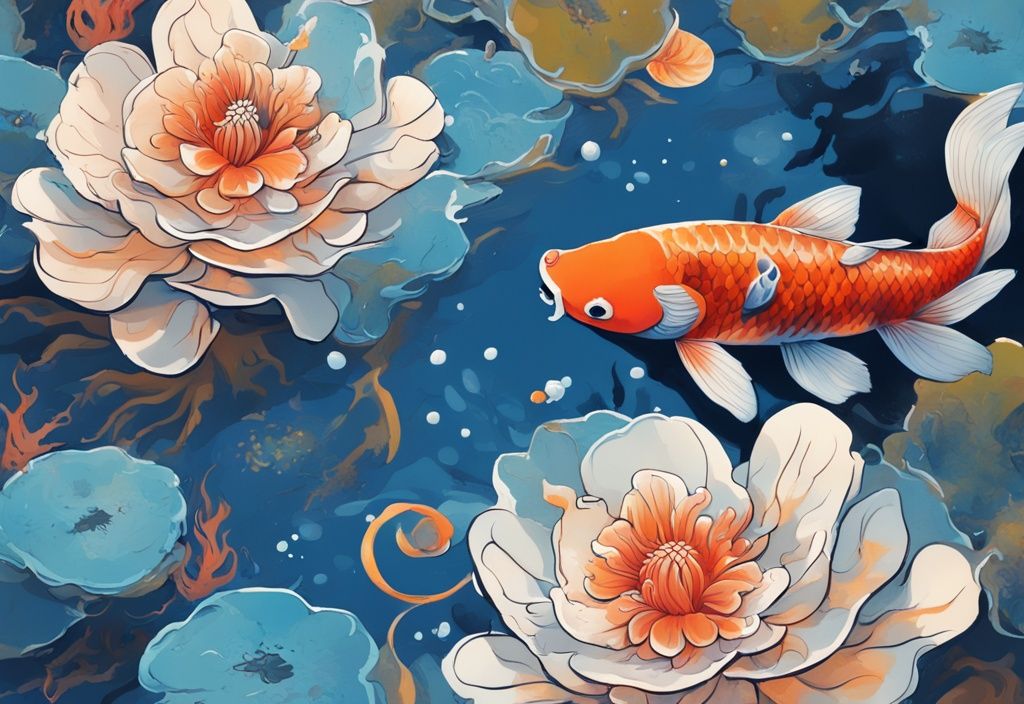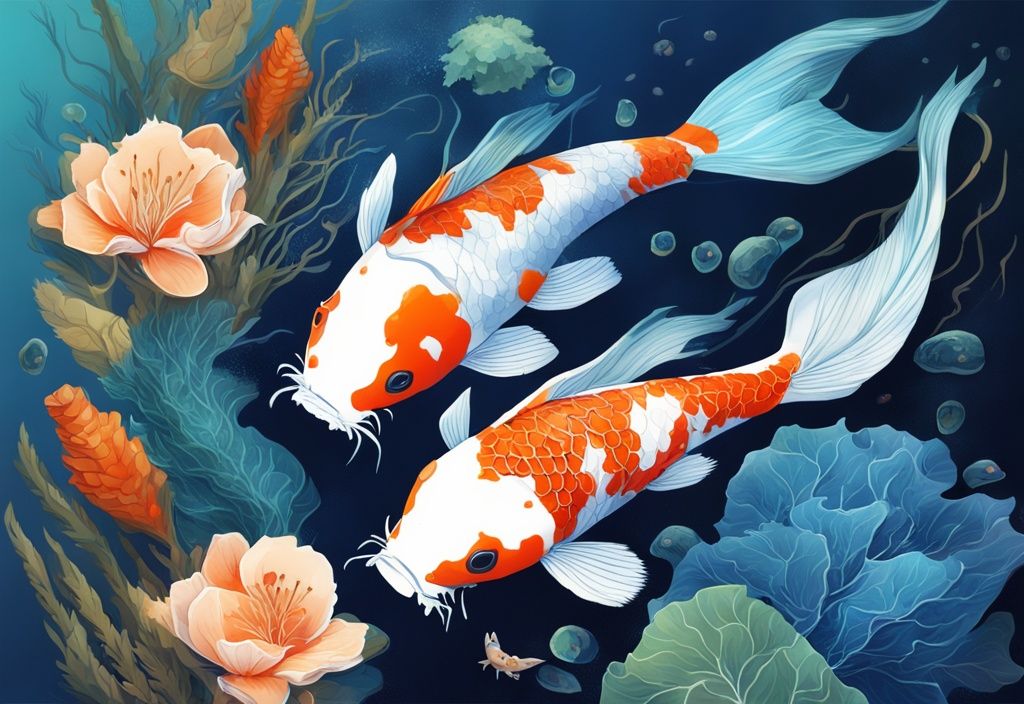Ever wonder if the dazzling colors and graceful glides of Koi fish are more than just eye candy? Well, they sure are! Their diet plays a starring role in this aquatic show. Whether you’re a pond pro or just mesmerized by these finned beauties, understanding their menu is key. Koi fish have a smorgasbord of dietary needs that shift with the seasons and their surroundings. From their wild foraging escapades to today’s gourmet fish foods, what you feed them can make all the difference. So, grab your net, and let’s dive into the world of Koi nutrition, ensuring your fish are not just surviving but thriving. Ready to reel in some knowledge?
Understanding the Diet of Koi Fish
Ever watched koi fish glide through the water, their vibrant colors shimmering under the sun? These creatures aren’t just eye candy; they have fascinating dietary habits that keep them thriving. Let’s dive into what makes up their diet, whether they’re in the wild or your backyard pond.
Natural Diet in the Wild
In the wild, koi fish are the ultimate opportunistic feeders. Picture them nibbling on algae, munching on plant bits, and snapping up insects like it’s a buffet. They even go after larvae, worms, and the occasional small fish. This varied menu ensures they get all the nutrients they need to grow strong and healthy. In a well-balanced pond ecosystem, koi can often fend for themselves, reducing the need for constant feeding from their human caretakers. Isn’t it amazing how nature provides?
Commercially Prepared Foods for Koi Fish
Now, if you’re like me and want to spoil your koi a bit, commercially prepared foods are a fantastic option. These come in all shapes and sizes—pellets, sticks, flakes—and are packed with essential vitamins and minerals. The beauty of these is their versatility; you can choose floating or sinking varieties based on your koi’s dining style. It’s like having a menu tailored just for them. Who knew feeding fish could be so much fun?
Human Foods Suitable for Koi Fish
And here’s a fun twist: koi can enjoy some of the same foods we do! Ever thought about sharing a slice of watermelon or a few peas with your fishy friends? They love it! Shrimp, fruits, and veggies can add a splash of variety to their diet. Just steer clear of high-carb foods like bread—those aren’t koi-friendly. By mixing in these human treats, you can make mealtime an exciting event for your koi. It’s a win-win, really.

Seasonal Feeding Habits of Koi Fish
Understanding the seasonal feeding habits of koi fish is essential for their health and vitality. As the seasons change, so do their dietary needs, and it’s crucial to adapt your feeding practices to ensure your koi thrive year-round.
Feeding Koi Fish in Warmer Months
When the sun’s out and the water warms up, koi fish are like little underwater athletes, buzzing with energy. Their metabolism kicks into high gear, and they need more fuel to keep up. This is the time to serve up high-protein meals that support their growth and energy. Picture them darting around in water that’s between 50 and 85 degrees Fahrenheit—this is their sweet spot for active feeding and digesting. If you find your fishing reel isn’t working properly, check out our guide on how to fix a fishing reel that won’t reel in. But remember, it’s a balancing act. Too much food can mess with the water quality and their health. So, keep an eye on those portions and enjoy watching your koi flourish.
Feeding Koi Fish in Colder Months
As the chill sets in, koi fish slow down, almost like they’re taking a winter nap. Their metabolism drops, and so do their food needs. It’s time to switch to wheat germ pellets, which are easier on their tummies in cooler water. These pellets pack the nutrients they need without overloading their systems. When the water dips below 10 degrees Celsius (50°F), it’s best to hold off on feeding. Koi enter a state similar to hibernation, and feeding them can lead to trouble with undigested food. Keep an eye on the thermometer and adjust your feeding routine to keep your koi happy and healthy during the colder months.
Feeding Practices and Precautions for Koi Fish
Feeding koi fish is an art, a delicate balance that ensures these vibrant creatures thrive in your pond. Understanding their unique dietary needs and the nuances of feeding can make all the difference between a flourishing koi community and one that’s struggling. Let’s dive into the essentials of feeding frequency and portion control, and the foods to avoid to keep your koi healthy and happy.
Feeding Frequency and Portion Control
Koi fish are a fascinating bunch, partly because they lack a stomach. This little quirk means they need smaller, more frequent meals. Imagine trying to enjoy a feast without a stomach! It’s a good reminder to keep their meals manageable. Typically, koi can be fed up to four times a day, but here’s the catch: only feed them what they can gobble up in about five minutes. This practice isn’t just about portion control; it’s about keeping the pond’s water quality pristine. Overfeeding can muddy the waters, quite literally, leading to health hiccups for your finned friends. Keep an eye on their eating habits, and adjust portions as needed. It’s all about maintaining that perfect balance in their diet and the pond’s ecosystem.
Foods to Avoid for Koi Fish
Now, when pondering what koi fish eat, it’s just as crucial to know what they shouldn’t. High-carb snacks, grains, fats, and dairy are big no-nos. These can cause digestive issues, and nobody wants a koi with a tummy ache. While peas and corn can join the menu, make sure they’re cooked to perfection for easy digestion. And here’s a tip from the wild: avoid feeding them anything caught in nature. Wild treats might carry unwanted guests like parasites or diseases. By sticking to these guidelines, you’re not just feeding koi; you’re nurturing a vibrant, thriving pond community.

Supplementing Koi Fish Diet
Understanding what koi fish eat is crucial for maintaining their health and vitality. While commercially prepared foods form the foundation of their diet, supplementing with fresh and freeze-dried options can enhance their nutritional intake. These supplements not only provide variety but also ensure that koi receive a balanced array of nutrients essential for their growth and well-being.
Fresh and Freeze-Dried Foods for Koi Fish
Ever wondered what else you can feed your koi fish besides the usual pellets? Picture this: your koi gliding through the water, vibrant and full of life. That’s what a varied diet can do. Fresh foods like chopped veggies and fruits are a fantastic addition. Think of lettuce and peas—easy on their digestion, while watermelon and oranges offer a refreshing twist. These natural goodies are packed with vitamins and minerals, boosting their immune system and enhancing those stunning colors.
But wait, there’s more! Freeze-dried foods are a game-changer. Proteins like shrimp, blood worms, brine shrimp, and clams are a hit. They’re rich in amino acids, crucial for muscle growth and energy. The best part? Freeze-dried options keep most of their nutritional punch, making them a top pick for diversifying your koi’s meals.
By mixing in these fresh and freeze-dried treats, you’re not just feeding your koi; you’re catering to their omnivorous nature. It’s like a buffet for them, ensuring they thrive in their watery world. Plus, you get the joy of watching them grow healthy and vibrant, adding a splash of beauty to your pond. So, why not give it a try and see the difference it makes?

FAQ
Ever wonder what those colorful koi in your pond munch on? Dive into these FAQs to uncover the quirks and preferences of koi dining habits. From the do’s and don’ts to their occasional oddities, let’s explore what keeps these finned friends happy and healthy.
Can Koi Fish Eat Bread?
Picture this: you’re tossing a loaf of bread into the pond, thinking you’re treating your koi. But hold up! Bread is a no-go for koi. Its high carbohydrate content can mess with their digestion and overall health. So, keep that bread for your sandwiches, not your koi.
How Often Should I Feed My Koi Fish?
Feeding koi is like a dance—rhythmic and precise. Aim for up to four times a day, but here’s the kicker: make sure they gobble everything up within five minutes. This way, you avoid overfeeding and keep the water sparkling clean. Nobody wants a murky pond, right?
What Human Foods Are Safe for Koi Fish?
You might be surprised by what koi can safely snack on. Shrimp, watermelon, peas, lettuce, and even oranges can add a splash of variety and nutrients to their diet. Imagine your koi nibbling on a slice of watermelon—it’s like a summer picnic in your pond!
Do Koi Fish Eat Their Own Eggs?
Now, here’s a quirky fact: koi are known to munch on their own eggs after spawning. It’s like a fishy family drama! Breeders often step in to separate the adults from the eggs, ensuring the next generation gets a fair shot at life. It’s all part of the circle of life in the koi world.


